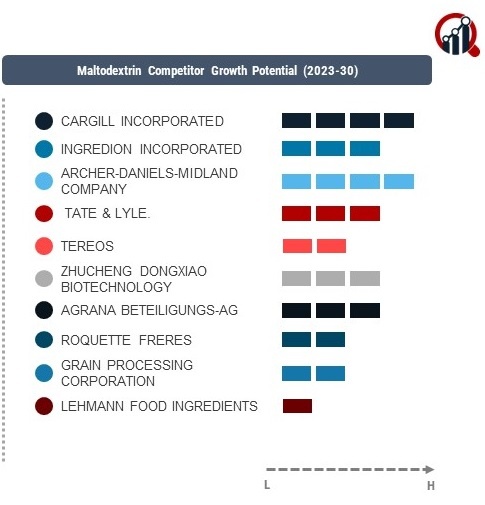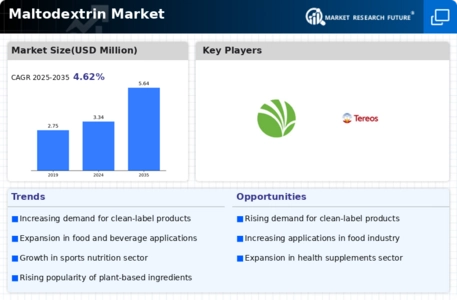Top Industry Leaders in the Maltodextrin Market
 Strategies Adopted by Maltodextrin Key Players
Strategies Adopted by Maltodextrin Key Players
The competitive landscape of the maltodextrin market is defined by key players that play a crucial role in the production, distribution, and application of this versatile carbohydrate. As of 2023, major companies influencing this market include Grain Processing Corporation, Cargill, Inc., Ingredion Incorporated, Roquette Frères, and Tate & Lyle PLC.
Key Players:
Cargill Incorporated
Ingredion Incorporated
Archer Daniels Midland Company
Tate & Lyle
Tereos
Zhucheng Dongxiao Biotechnology
Agrana Beteiligungs-AG
Roquette Freres
Grain Processing Corporation
Lehmann Food Ingredients
Strategies Adopted:
The maltodextrin market revolve around product innovation, geographical expansion, strategic partnerships, and sustainability. Product innovation is crucial, with companies investing in developing maltodextrin variants tailored to specific applications and addressing consumer preferences for clean label and functional ingredients. Geographical expansion involves entering new markets, adapting products to regional preferences, and forming strategic alliances to address the increasing global demand for maltodextrin. Strategic partnerships with food manufacturers, research institutions, and distributors facilitate the integration of maltodextrin into a wide range of products and ensure compliance with industry standards. Sustainability initiatives focus on responsible sourcing of raw materials, eco-friendly production processes, and reducing the environmental impact of maltodextrin production.
Market Share Analysis:
The maltodextrin market include product quality, pricing strategies, brand reputation, distribution networks, and customer relationships. Product quality, in terms of purity, texture, and functionality, is essential for gaining consumer trust and meeting industry standards. Pricing strategies, whether positioned competitively or as premium products, impact market share by targeting specific consumer segments. Brand reputation plays a significant role, with well-established brands often enjoying preference in the market. Efficient distribution networks, including partnerships with food manufacturers, distributors, and retailers, contribute to market reach and accessibility. Building and maintaining customer relationships through effective marketing, customer support, and consistent product quality are crucial for securing and expanding market share.
News & Emerging Companies:
The maltodextrin market has witnessed the emergence of new companies and trends in response to the growing demand for versatile and cost-effective carbohydrate solutions. Emerging companies often focus on niche segments, such as organic maltodextrin or maltodextrin alternatives, to differentiate themselves in the competitive landscape. Additionally, advancements in processing technologies, such as enzymatic modification, have gained traction among emerging players seeking to offer maltodextrin with improved functionalities and reduced environmental impact.
Industry Trends:
Industry trends in the maltodextrin market highlight a continued focus on sustainability, technological advancements, and market expansion. Many companies are investing in sustainable sourcing practices, energy-efficient production processes, and reducing water usage to align with the increasing consumer preference for eco-friendly products. Technological advancements involve adopting innovative processing technologies to enhance the functionality of maltodextrin and cater to specific industry needs. Market expansion efforts include entering new geographic regions, exploring untapped applications, and collaborating with local partners to capture diverse market opportunities.
Competitive Scenario:
The maltodextrin market remains dynamic, with established players adapting to changing consumer preferences and emerging companies contributing to innovation. Market dynamics are influenced by factors such as the versatility of maltodextrin, its wide range of applications, and the evolving needs of the food, pharmaceutical, and industrial sectors. The resilience of the market is evident in its ability to cater to diverse industries, from food and beverages to pharmaceuticals and personal care.
Recent Development
The maltodextrin market presents a competitive landscape shaped by key players employing diverse strategies to meet the evolving demands of various industries. The emphasis on product innovation, geographical expansion, strategic partnerships, and sustainability underscores the industry's commitment to addressing changing market dynamics. As the market continues to evolve, companies that can balance functionality with sustainability and adaptability are likely to maintain a competitive edge in the dynamic landscape of the maltodextrin market.

- Beta
Beta feature

